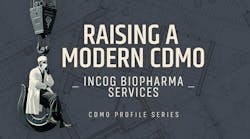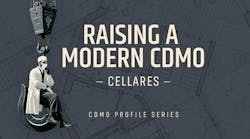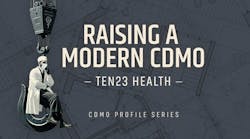KaloBios Pharmaceuticals Inc. announced in January it had appointed Harry Lam, Ph.D., as head of manufacturing. His appointment is an important one, no doubt signaling KalosBios’ intention to secure strong leadership to successfully guide the development and commercialization of its portfolio of patient-targeted, first-in-class monoclonal antibodies designed to treat cancer and sever respiratory disease.
Strong leadership is guided by experience and KalosBios’ president and CEO David Pritchard points to it directly: “His experience in directing science and technology on a global basis for drug substance manufacturing will be especially pertinent … as we continue to advance the development of our patient-targeted antibody therapeutics toward commercialization.”
His new appointment aside, over the course of his 30-year career, Dr. Lam has maintained a focus on operational leadership across some of the industry’s most prominent and innovative companies. Most recently, Lam was vice president and head of manufacturing for Shire Regenerative Medicine, preceded by 17 years at Genentech where ultimately he served as global head of contract manufacturing. During his time at Genentech, Lam led and managed the technology and operations groups in the commissioning, qualification, tech transfer, process validation and licensure of Genentech’s bacterial facility in Singapore.
Lam’s resume highlights a career spanning the institution of cGMPs and the growing role and prominence of CMOs in supporting the strategic business aspirations and competitiveness of Pharma on the global stage. The state of contract manufacturing is incredibly dynamic of late, and branded pharma as well as generics are increasingly turning to contract manufacturing organizations for higher, more sophisticated levels of support across multifaceted global supply chains. “They have to have the right capacity at the right time, and that’s not a simple thing because sometimes you want to field a lot of capacity to take advantage of scale and emerging markets,” says Lam. “But as everyone knows, things can change quite dramatically so you don’t want to be over built, but you also want to be able to capitalize on business trends and deliver drug product reliably.”
In recent years organizations have pursued operational flexibility, seeking to have the ability to quickly introduce capacity to support a given customer’s strategy in developing and emerging markets through the support of CMOs. “Each drug owner has a different percentage of what it produces in-house versus what is provided by external manufacturing partners,” says Lam, using a term he finds more apt in characterizing contract manufacturing relationships. In general, the strategy is about looking for a sweet spot in terms of what percentage of manufacturing assets is in-house, and what’s provided by external partners.”
IMPACT OF cGMP
Ever since they were introduced more than 14 years ago, the impact of the FDA’s GMPs for the 21st Century are still being felt, and Lam has had a seat at the implementation table from their inception. “I think, in general, there are those in the industry with the view that the bar is being raised all the time by the authorities,” notes Lam, “but actually through all the years, I really believe that the health authorities are truly looking out for the benefit of the patients, the safety of the patient. So [the FDA] came up with a way to lead the industry on how to produce high quality product for the patient.” Lam explains regulators are trying to find the right balance a safe supply and a reliable supply to meet consumer demand. “It’s about reliable supply of high quality product to the patient,” says Lam, “so through the years, I think if you look at the industry and cGMPs it’s certainly continuing to evolve, but it seems to be increasing the quality products.”
Lam explains that in his experience all Pharma companies, including contract manufacturers, have different degrees of success approaching and meeting the high expectations of health authorities. “Some companies are much closer to meeting them, others not so much,” says Lam, “something reflected by their regulatory inspection of performance. It’s like water, either you’re below the surface or you’re above it. I think some manufacturers may be closer to the water’s surface and occasionally dip below it — and that’s when you’re in trouble.”
It seems to Lam that when one looks at major contract manufacturing organizations and at levels of inspection, as well as levels of 483 observances, warning letters, and consent decrees, etc., if you’re able to manage well, and if you have operational excellence in the forefront of your organization, then you’re able to respond well and push your head above water. “I would say manufacturers, either internal or external, that in our business, that you really have to pay attention to your operations — it’s a slippery slope. If you don’t, it can get you below water pretty quickly.”
Lam explains that it’s about regulators’ confidence in a manufacturer. Once the regulator loses confidence, everything that was previously acceptable now becomes unacceptable and then become citations and warning letters.
“The second thing regulators do, especially with manufacturers that have a network of facilities,” notes Lam, “and so are many of these are multinationals, with big formal networks. [Regulators] really expect the standard to be maintained for every site; one can not just say, ‘Well this is just one manufacturing site’ — if one site has problems, then the entire network has problems. That’s a lesson learned for me.”
Quality and risk management are at the forefront of this conversation, says Lam, and Pharma companies cannot just offload manufacturing to CMOs and expect to shed the risk and liabilities along with the contract. Recent guidance from the FDA regarding the roles across quality systems and risk management with CMOs and the substance or drug owners is being defined a little bit better and, ultimately, that looks like a good thing.
DIFFERENCES BIG AND SMALL
All CMO pharma manufacturers will face challenges, with regulators, with quality processes, with operations on the road to compliance and commercial success, says Lam; in the cGMP world order he accepts that contract biopharmaceutical manufacturers may be particularly challenged. “In the small molecule world, the focus is a lot more about — because we can characterize the final product so well — that you can put in a lot of testing and quality control to assure QA and make sure that it’s safe, high quality and meeting all the expectations of identity and all the detail things that one can do to characterize it,” explains Lam.
“But it’s well known that for biologics, the process is the product. For small molecule [compounds] there’s a lot more focus on the end product, because the product is well characterized to begin with,” says Lam. “However, from a compliance perspective, regulators are actually putting more and more emphasis on process because it’s a biologic, it’s so difficult to really fully characterize the product.” Lam says the entire process is important from a regulator perspective, and that it is important self-impose requirements to make sure the entire process is well characterized because with biologics one cannot fully characterize the final product.
Managing toward operational excellence is more or less mandatory and Lam agrees. “I cannot tell you enough how important it is, not just to the regulator. I think it’s a good thing to do, as a manufacturer, to be able to continue to look at what are the potential risks in your process that may not allow you to make the products that you need to make.”
Lam explains that there are doubts about QbD because it’s so complicated and it requires so much work that some regulators are realizing that full-blown QbD may be the provenance of only a few really big manufacturers because they are the ones who can afford it.
“But let’s not throw away the baby in the bath water,” says Lam. “It’s a fact that it’s difficult to do, perhaps we need to just agree that sure it’s a great concept and always strive to look at and understand process and keep working on implementing it to meet its intent.” Lam notes that the industry and regulators are evolving in that direction.
“I think that regulators are really concerned about shortages and again it’s about what I said right from the beginning. It’s about balance; it’s about needing to have high quality products and make sure that patient safety and quality, as well as availability are delivered,” Lam concludes. “The regulators really want to work with the industry to make sure that we have this quality culture; that throughout the entire lifecycle of the process, from development to getting approval to post approval, there is continuous monitoring and improvement. I totally understand where the FDA is coming from, and I agree that it is the right thing to do and the right way to do it.”





